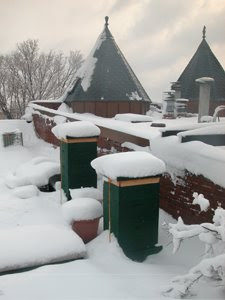
It's been a while since I last inspected the beehives (back on
9/13 to be exact - almost 3 weeks). One of those weekends was taken up by a
bee club meeting. The other weekends had really lousy weather, and I didn't feel like bothering the hives.
I had a middle-of-the-day meeting at my son's school today, so I worked from home. The weather was nice (mid 50's) and the sun was shining, so I decided to do an inspection this afternoon.
Since the last time, I ordered and received some medications to help the bees make it through the winter. There is a Apistan for the Varroa mites, and Formic Acid pads for the tracheal mites. I also got some medicine for the Nosema parasite, and I will mix that in with some sugar syrup to feed them this month.
The weather has been chilly most of the last couple of weeks - we went right into fall head first. So the bees will be starting their winter preparations. They will eventually begin to "cluster" which means keep together in a group in the hive for warmth. They move down to the bottom chamber, and during the winter, they literally eat their way upward (consuming honey as they go). So it is important that they have honey accessible.
I started with the green hive, which seems to be the gentler of the two hives. Today was no exception - no problems taking apart the hive. Since that hive started August 1, they aren't as large as the brown hive.
This picture shows the Apistan strips inserted in between the frames:

You can see the tops of the strips (twisted over to keep the strips from falling down). As the bees move around, the miticide rubs off onto the bees, and it kills any mites. Over time, the pesticide makes its way to all the bees. You have to remove the strips at 6 weeks, otherwise the mites can build up a resistance.
I also put a Formic Acid pad on the hive:

It sits on a couple of sticks so the bees still have access to the tops of the frames. You add a small spacer (shown above as the unfinished wood frame on top - I built those myself) so things don't get crushed. The pad stays on for 3 weeks, and the heat from the sun and from the hive vaporizes the formic acid, which kills the tracheal mites.
I didn't go too deep in the hive. I pulled out a frame and saw capped brood, so I left things alone.
Then I moved on to the brown hive. That hive is in a lot worse shape than the green hive, since early on the bees were very uneven in how they built up the comb. I pulled out an end frame, and it was full of honey and the top of the honey was too tall that it scraped open when I removed the frame. The bees went a little crazy (as they do when there is exposed honey), so I quickly put the medicines on and closed up the hive. The guard bees were giving me a hassle also.
I refilled the feeder jars with 2:1 sugar syrup to feed the bees in both hives. I have about another 2 quarts of the regular syrup to go, then I'll mix up a couple of gallons of 2:1 and put in the Nosema medicine. Then I'll keep feeding until it gets too cold to take syrup.
I'm not sure what I am going to do for the brown hive, to help correct some of the problems in it. I hope that when spring comes, and they have emptied out most of the honey, I can swap out some frames to try to even things up. I also have a frame in that hive where a piece of the wood split off, so that it doesn't stay separated from the next frame, and can be squeezed over too close. I have to keep an eye on that frame when I push the frames together, to keep it from getting too close. So we'll see next year if I can swap out some frames.
So finally, here's what the hives look like, and this will probably be the winter configuration:

I still need to put in a
mouse guard over the entrance, and probably put some styrofoam insulation under the hive (blocking the
screens on the bottom boards to keep the drafts out) and maybe some inside the inner cover. People have varying opinions on whether that is good or bad - we'll see.

























